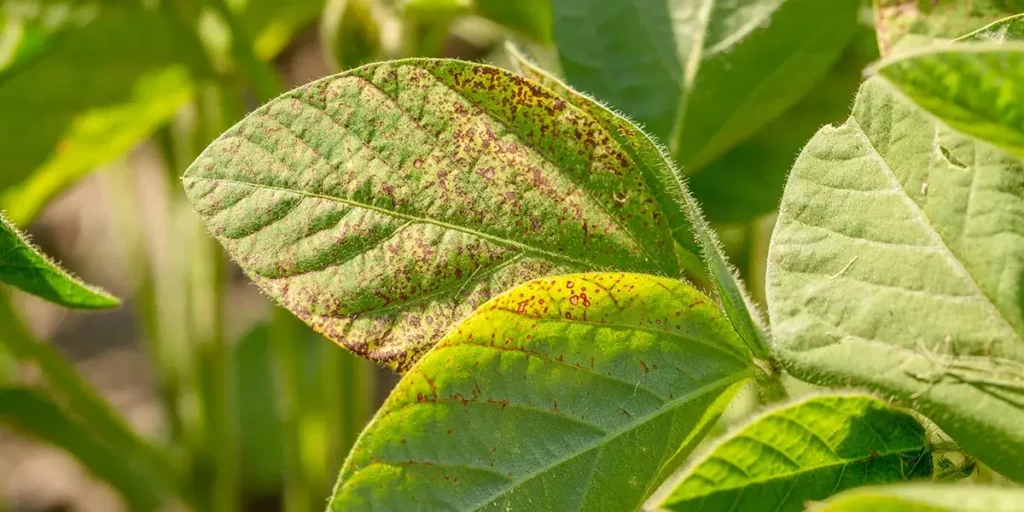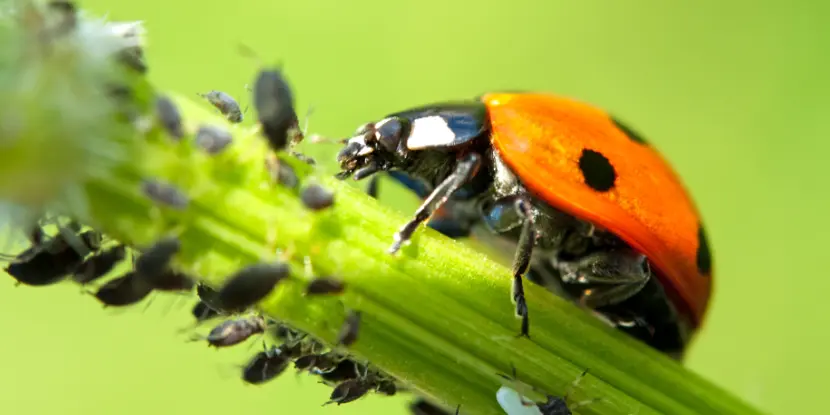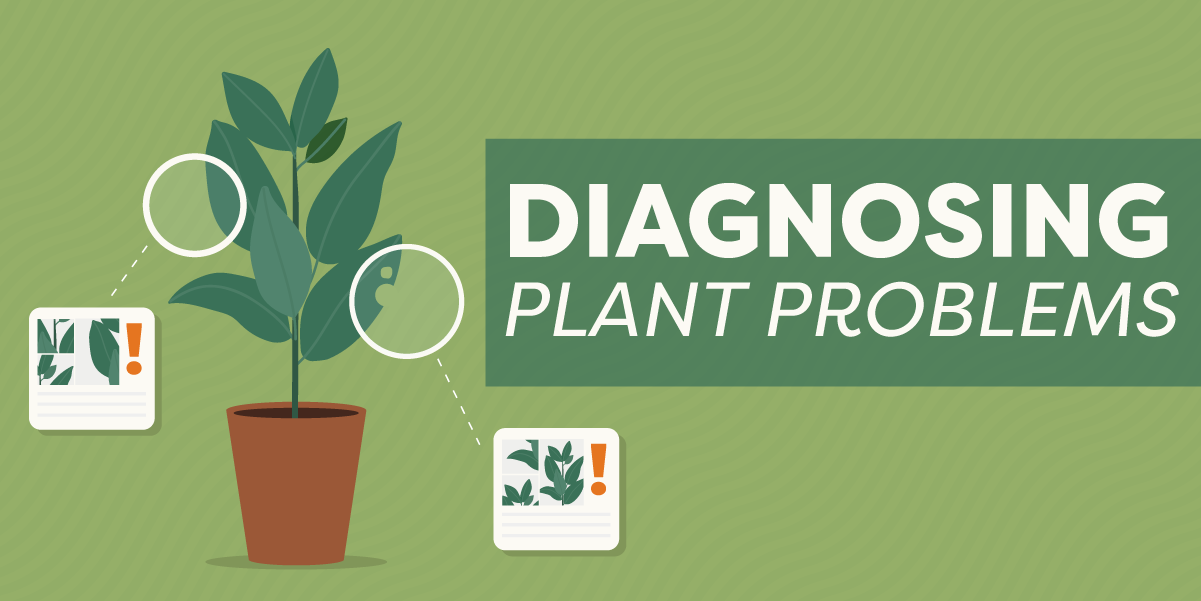Plants and shrubs are vulnerable to attack by insects and diseases (primarily fungi). When the symptoms are similar, such as damage to leaves, bark, or other parts of the plant, it can be hard to diagnose the problem.
Guessing wrong can make the problem worse. Improper treatments fail to help the plant, and by the time you make a correct diagnosis, it may be too late to save a plant already too stressed to recover.
How to Diagnose Plant Pest & Disease Problems
Bug or Disease?
(GARDENER’S TIP: “Picture This” App ) The Picture This app can diagnose most problems and tell you if they’re insect or disease-related. You’ll know which insects or diseases are involved and how to treat the plant.
The app can also identify plants from a photo you’ve taken, so that you can identify a new plant as a weed or desired plant. And it can expand your botanical knowledge when you’re out on walks or visiting the park, and you’d like more information about the plants you encounter.
While apps like Picture This are fabulous tools for the gardener, they’re not foolproof. Therefore, I always recommend a second check.
- Examine the plant’s leaves for evidence of insects.
- Start by brushing your plants with your hand or a stick to disturb the leaves. If insects fly off them, then insects are the likely culprit.
- Next, examine the leaves, especially their underside, for insect larvae or resting insects. Many harmful insects like thrips and spider mites are almost invisible to the naked eye. The good news is your cell phone can serve as a magnifying glass with the help of your camera or a magnifying app.
Your 4-Step Plant Treatment Plan
- Determine if you can save the plant.
- Correctly identify the problem (type of disease or insect)
- Eradicate the disease or insects
- Implement preventative maintenance & management
Details below!

Disease on a plant leaf.
1. Determine If You Can Save the Plant
The good news is that most infected plants can be brought back to full health. The key is early treatment. If over 50% of the plant is infected or infested, then removing the plant might be the best option. It can be challenging to save plants this far gone, but there are other things to consider:
- Plants with an insect infestation are easier to save than plants with a comparable infectious disease. Killing insects and larvae is more immediate, while disease will require more protracted treatment. The disease may be systemic at the roots or inside the plant.
- It’s harder to stop a disease infection on over 50% of a plant without further damage occurring.
- Disease-infected plants are more likely to infect neighboring plants. Removing the infected plant might save other plants.
- Some plants can be cut hard to remove the infection or infestation. Typically, perennials will regrow if cut hard (trimmed close to the ground), as will some annuals — as long as you keep some stems and leaves on the plant.
2. Correctly Identify the Problem (Type of Disease or Insect)
As mentioned, I recommend the Picture This app for preliminary diagnosis of the problem, followed by a manual check for pests. I’ve outlined the process earlier in this blog.

Aphids on a plant leaf.
3. Eradicate the Disease or Insects
Thrips, spider mites, and aphids are common in Southern California and can be eliminated with the same insecticide or natural organic product.
Brown spots, black spots, and white powdery mildew are common infections and are easy to identify. Most anti-fungal disease products will fight all three of these as well as some forms of blight.
Natural and organic products are best if you catch the problem early. They’re also best for ongoing management and disease and insect control. I recommend Bondie products, sold at Anawalt and other fine garden centers.
Chemical products might be necessary for severe outbreaks that demand immediate results to prevent the spread of the infection. The severity of the infection will determine what type of products you should apply. Chemical products like Sevin (insecticide) and Daconil (fungicide) should be used only in extreme cases.
Insect eradication with natural products takes more time. Organic treatments don’t necessarily kill insects but make the plant inhospitable to them. They encourage insects to take up residence elsewhere and interrupt their breeding cycle, preventing additional damage to the plant.
Infection eradication with natural organic products won’t cure the existing infection on leaves (infected leaves should be removed), but it will stop the spread to other parts of the plant. Extreme infections may require chemical treatments, which will kill the existing infection and stop the spread.

A ladybug preying on aphids.
4. Implement Preventative Maintenance & Management
Preventative maintenance and management begins in the spring and lasts all summer.
2Spraying your plants with a good natural organic insecticide and anti-fungal product will help prevent outbreaks during the growing season. It can also help manage small outbreaks and make it easier to eradicate them.
Most natural products recommend a 7 to 14-day cycle of treatment. These products are best for the environment, and they won’t harm creatures that eat the “bad” insects. They’re also safer for people and pets.
I recommend Bonide natural products for insect infestations or disease infections. These are sold at all Anawalt Lumber, Hardware, and Nursery locations in ready-to-spray bottles and concentrates.
FAQs: Plant Pests & Diseases
Q: What are the most common plant pests in Southern California?
The most prevalent insect pests include aphids, spider mites, whiteflies, and the invasive Asian citrus psyllid, which targets citrus trees.
Q: How can I tell if my plant has a disease or insect infestation?
Insect damage often appears as holes in the leaves, or you may see the insects on the plant. Disease symptoms may include unusual leaf discoloration, spots, or powdery substances on the leaves or stems.
Q: What is the first step in treating a plant affected by pests or disease?
The first step is accurately identifying the pest or disease. This may involve closely examining the plant and consultation with local nurseries or extension services for advice.
Q: Are there environmentally friendly ways to control pests on my plants?
Introducing beneficial insects (like ladybugs for aphid control), applying neem oil, or making homemade insecticidal soaps are eco-friendly options for managing pests.
Q: Can overwatering lead to plant disease?
Overwatering can create an environment favorable to fungal diseases like root rot and powdery mildew, especially in the warm Southern California climate.
Q: How often should I inspect my garden for signs of pests and disease?
We recommend weekly inspections to detect any signs of pests or disease early on, making them easier to manage.
Q: What should I do if my entire plant is covered in pests?
A: If an infestation is severe, you might need to remove and dispose of the entire plant to prevent the pests from spreading to nearby plants.
Q: Are chemical pesticides safe for all plants?
Not all chemical pesticides are safe for every plant type. Read labels carefully and, when in doubt, consult with a professional or use organic alternatives.
Q: Can plant diseases spread from one plant to another?
Many plant diseases, especially those caused by fungi or viruses, can spread from one plant to another through water splash, contaminated tools, or insects.
Q: What’s the best way to prevent pests and diseases in my garden?
Practice good garden hygiene, including proper spacing, watering practices, and regular cleanup of fallen leaves and debris. Also, choosing disease-resistant plant varieties significantly reduces the risk of problems.

